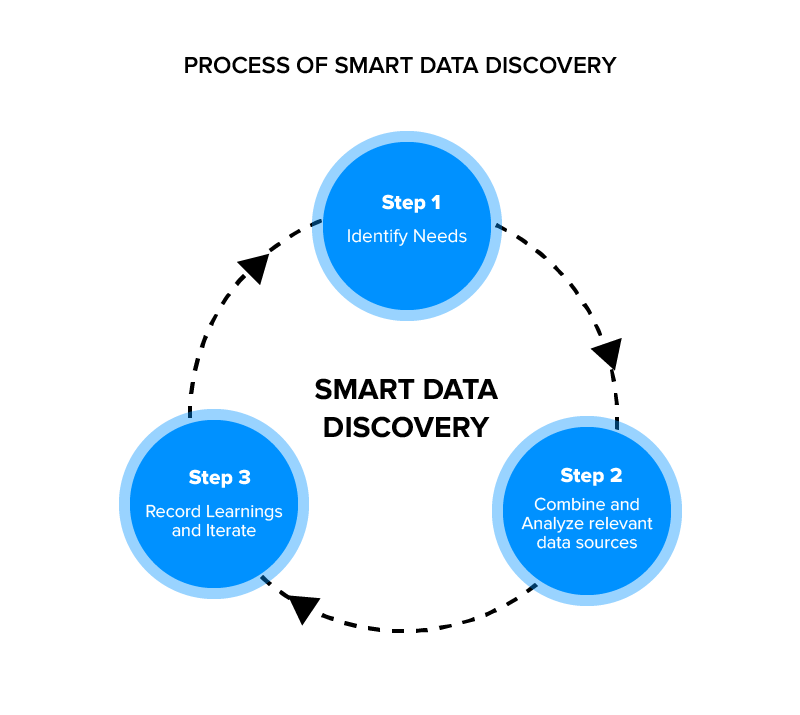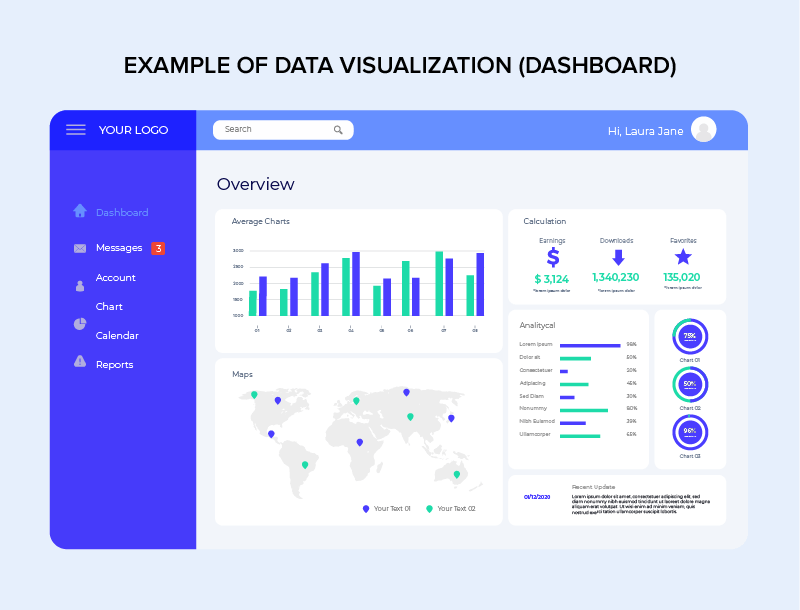This phrase is meant to communicate the idea that your business data can be extremely valuable if utilized the right way. Data has the potential to fuel an entire organization only if it’s organized and studied every single day.
A study states that by 2025, the total amount of data created, captured, copied, and consumed globally is expected to project over 180 zettabytes. This makes it extremely difficult to imagine the data silos generated by a single organization. In this data-driven world where IoT (Internet of Things) and BI (Business Intelligence) are the priority of the day, over 60% of organizations are struggling with unstructured data.
Therefore it’s crucial for enterprises to look for data solutions that allow them to seek out the value of their data from information, metrics, and insights. One such solution is data discovery.
Data discovery: Crack the storyline of your business data!
Data discovery is a process that involves analyzing and collecting data from multiple sources to discover outliers, trends, and patterns within the data.
Data discovery covers both structured and unstructured data and helps generate data visibility throughout the organization.
Now, what do you get out of data discovery?
You can leverage the insights gained to enhance your business process and stand out in an already saturated digital ecosystem. Almost every business collects massive data from vendors, suppliers, customers, operations, and production processes, both from traditional and digital transactions.
Not taking advantage of this data can keep you drowned with useless information. This is when you need data discovery to analyze the information, automate the management and help you visualize your business in a big picture.
Now that we are on this topic, you’d be surprised to know that the global data discovery market size is projected to reach USD 14.4 billion by 2025, growing at a CAGR of 15.6% compared to 2020. This growth is due to certain market dynamics such as :
- Increased adoption of cloud-based data
- Increased investments in data privacy
- Interest in data discovery to improve compliance and governance
- The growing need for data utilization post-pandemic
- Increasing demand to discover sensitive saturated and unsaturated data

The shift from manual to smart data discovery
Previously, the enterprises have been practicing data discovery manually with the help of excel sheets, carrying out documentation and analysis all by themselves. Experts called it an inefficient process that took a lot of time and effort. The insights gained were also highly dependent on the individual’s understanding of data and were subjected to human errors.
Manual data discovery included manual data mapping, categorizing metadata, documenting rules, and gaining insights using critical thinking.
With the introduction of Artificial Intelligence (AI), Business Intelligence (BI), and Machine Learning (ML), smart data discovery has become the go-to process for every modern data-driven enterprise. With the help of this automated data system, enterprises can easily conceptualize and present the data insights on an integrated platform.

Smart data discovery includes automated data preparation, integration and presentation of hidden patterns, and visualization of trends and information for smart decision making.
This seamless data translation process empowers businesses with real-time actionable changes that directly impact growth and profitability.
Three categories of the smart data discovery concept
Smart data discovery process comes in multiple forms, combining analysis, visual outputs, and modeling. To attain maximum value from this process, you first need to understand the format of how data discovery works. Below are the three categories of data discovery that can help you gain a bigger picture of data operations.
1. Data preparation
Data preparation is the most vital step that comes before any discovery and analysis. This step involves cleaning the data (structured and unstructured), reformatting, and merging that data from all sources to be studied in a consistent format. The better you prepare your business data, the effective insights it provides. If you ask how the data prepares itself?
The data might deduplicate, detect outliers, delete the null values, and format itself to high quality for better analysis.
2. Data visualization
Data visualization is another effective way to fully comprehend business insights. Here the data is visualized in the form of dashboards, flow diagrams, charts, and other formats. This is basically the result of predictive analytics and machine learning. This comes in handy for non-technical department teams to understand the relationship among various data streams.
For instance, your finance team can analyze the cost vs. revenue and pinpoint the areas of improvement for every department.
In the same way, your design team can monitor the entire customer lifecycle using the same data source and function accordingly.

3. Advanced analytics
This is where the description and visualization part is merged to get a complete picture of the company’s business data. This advanced analytics and reporting system organizes, summarizes, and breaks the complex data into simple, intuitive reports for future decision making.
Why is smart data discovery essential for your business?
So far, we have discussed several applications of smart data discovery. However, these applications and perks are not just limited to smart and insightful decision-making. Below are the top five benefits of smart data discovery for modern enterprises.
1. Automatic data classification
Enterprises collect more data from thousands of sources every day in new formats. Through a smart data discovery system, you can classify all of this information precisely based on the condition, channel, and context in which it is collected.
For example, retailers and manufacturers can differentiate between the consumer data collected from the sales, marketing, and service teams to merge and assess the entire customer experience. Without data discovery, they would have to go through every single piece of data separately.
2. Real-time data controls
You can apply specific actions to your data using different data discovery techniques, such as predefined control over data. This gives you actionable full-time control over your company’s data. For example, you can easily compare your current year’s profit margin to the previous year’s profit and gain insights into future profit probabilities.
3. Improved compliance and risk management
As the data volumes grow and the consumers get more invested in data protection and security, compliance and risk management are on the top of every enterprise’s agenda. As mentioned above, smart data discovery spots the potential threats and outliers in the data so you can manage them proactively.
With the trending smart data discovery features, you can also stress test your data management practices to ensure that your business complies with the General Data Protection Regulation (GDPR).
4. Democratized data insights
Data should not be only understandable to IT experts and data analysts. With a smart data discovery system, data insights are easily accessible to nontechnical departments such as sales and HR along with clients and stakeholders. In short, data discovery can be an all-in-one solution for every team’s needs.
For instance, the sales team can put figures to strategize how to stop lead expenses. Data discovery can help visualize the same figures to the marketing team to analyze the customer’s call to action points. This way, one data source can be used for unique analysis and decision-making.


